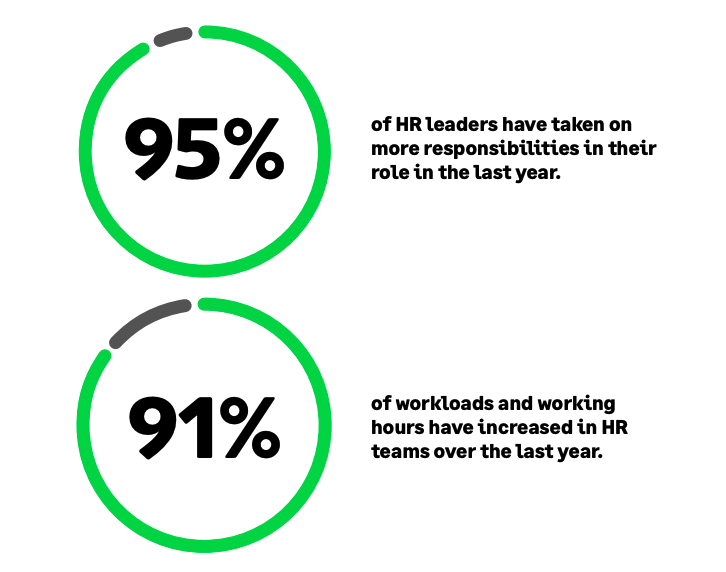95% of HR leaders say their responsibilities are widening*. But what if there were a people strategy silver bullet?
A business and people focus that could improve the attraction and retention and skilling of top talents, and boost profits and performance for the business.
All the while improving the employee experience, as well as a customer experience, that could adapt and transform as the market and business landscape change around it.
The fix-all? Employee engagement.
In fact, pressure on HR leaders can be alleviated by knowing the latest employee engagement trends and how to make an employee engagement strategy.
In today’s article you’ll learn:
● A definition of employee engagement as well as what employee engagement benefits are
● The key parts of making a people strategy with employee engagement at its center
● Why an employee engagement survey is critical
What is employee engagement?
Employee engagement can be difficult to define. But the key pieces parts of the definition are below:
● Employee engagement is a psychological state, relating how employees connect to their teams, the work, and the business and its goals.
● It will contain elements of how an employee connects to the organizational culture and the employee experience.
● It is viewable or measurable by how engrossed in the work, how much energy and how dedicated an employee is (which can be quantified).
This is useful for giving a three-dimensional starting point for employers who want to consider all the important factors, understand the reasoning behind the thinking, and how to define it for their own organization.
But of course, this will require an understanding of how this fits into a specific organization — before using this definition to help build a strategy to obtain employee engagement benefits.
What are employee engagement benefits?
Defining what employee engagement is, indeed, is only the starting point. Critically important is understanding how employee engagement benefits the organization.
HR chiefs are increasingly landed with C-Suite agenda items that are regularly positioned as the business’s most critical issues. The urgency of these requests is ratcheted up on an uncertain business landscape. It’s a lot for HR leaders to deal with.
Why? HR leaders know too well that leveraging the benefits of an employee engagement programme can help them align with the business, understand how it informs HR practice, and communicate effectively to get all-important leadership buy-in.

Then, when the benefits are understood, it’s about realizing employee engagement isn’t a once-and-done initiative. Rather the employee engagement strategy will need to be wrapped, for the long term, into the people strategy, measured, and continuously adapted to people and business needs.
So what are employee engagement benefits?
1. Boosts organizational performance
Engaged employees result in an uptick in performance for the organization. Research shows that employee-centric HR approaches have positive impacts on team performance, company morale, and well-being.
This boosts profit margins, productivity customer loyalty, and the overall business as well as having futureproofing benefits. Great for hard-to-predict times.
2. Better individual performance
Organizational performance can hardly be boosted by a focus on employee engagement if this focus doesn’t boost individual productivity and efforts.
Gallup has found that there is a huge difference between employee behaviors and performance at companies with low engagement and high engagement.
At the organizations with the highest engagement levels — i.e. those firms working to get employee engagement benefits — employees were less absent, more likely to be safe, and more often turned out quality work.
3. Improved talent management
Engaging employees enough to stick around is critical to boosting individual and organizational performance. Deeply important for a world where deep expertise and company knowledge can be a competitive edge.
4. Building an employee engagement infinite loop
One of the best benefits of engagement? It can be self-perpetuating and reinforcing.
If an organization is implementing an action-led engagement strategy (clearly defined, rolled out, continuously adapted, and measured to be improved) then not only do engaged workers likely create better organizational outcomes but those improved outcomes then boost engagement in workers. What’s not to like?
5. Trust in leaders
In changeable times, trust is critical to reaching organizational goals. Getting employee engagement right can ensure leaders get support for future plans — even when those include difficult transformation projects.
How does this work? Engaged employees believe that leaders show integrity and are focused on future-proofing the business.
Engagement helps employees feel their voice is being heard by the leadership and that their ideas are taken into account in future strategic movements.
How to build an employee engagement strategy
So, surely the million-dollar question for HR leaders is: how can my organizations get all these employee engagement benefits? It requires a multi-part people strategy that speaks to engagement fundamentals and takes into account current trends.

Below are five key steps in building an effective employee engagement strategy.
1. Get leadership buy-in
Success in HR programs hinges on leadership buy-in. It can mean people leaders showing the C-suite clear ROI, and tangible benefits, using storytelling and data.
Luckily, when it comes to employee engagement, executives are already bought in. Over nine in 10 believe that engagement improves, teams work better and employees have longer tenure and improve bonds with colleagues if they are engaged.
This doesn’t mean HR shouldn’t communicate the benefits, though.
2. The leadership boost
Getting buy-in from business leaders for employee engagement strategy benefits the engagement action plan itself.
Key enablers of employee engagement are the C-suite leadership, who control the strategic narrative and set goals, as well as team leaders who operationalize the day-to-day efforts here and can feedback on what’s working, giving employees a voice.
3. Narrowing employee engagement focus
Define. Roadmap. Action.
Doing employee engagement well means having narrow areas of focus.
This might start with a strategic umbrella goal (such as boosting employee motivation) which can be narrowed into clear, measurable actions (measuring commitment, surveying employees to see if they understand goals, and building programs to boost motivation).
This not only helps create clarity of action but can help HR measure efforts and continuously improve, tweak, and adapt the employee engagement strategy.
4. Holistic, strategic engagement
Having clear focus areas and actions for engagement doesn’t mean neglecting how engagement fits into the broader HR strategy. Whether it’s a focus on workplace culture, the benefits package, L&D offering, or management techniques, HR should be asking: how does this engage employees?
It means HR should always be focussing, through all of its remit, on how employees are motivated, and how they connect to teams and the organization.
From HR, this can be boosted by encouraging business leaders to take center stage, using clear comms, and focussing on critical points of engagement hotspots (recruitment, performance management, annual reviews).
5. Measuring for success
Without measurement, there can be no way forward. It’s only from employee insights that HR can ensure they are making headway on the employee engagement agenda.
However, measuring engagement effectively can be difficult. Organizations might not only the engagement-related program itself (a new well-being initiative or bonus scheme) but also the intended business outcomes (such as a profit margin, sales volume, or health metrics).
HR also needs to systematically gather and interpret data through employee engagement surveys and by using the right tools and HR analytics approaches. Measurement will have to be continuous, too.
It’s about getting as much data as possible to understand what drives people as the operating environment transforms around them.
How to make sure employee engagement efforts boost HR strategic performance
Indeed, assessing the employee engagement strategy can be a shorthand for understanding HR performance itself.
These employee insights can help HR ask:
● Are employee engagement efforts aligned to, and steering, the business strategy?
● Does employee engagement strategy positively shape the working environment, talent attraction, and development?
● Does the organization engage employees on how they want their well-being to be taken care of, their voice to be listened to, and what they consider fair reward?
● Does your HR strategy unite employees with the business purpose, values, ethics, inclusion, and integrity?
Even if HR can come up with clear answers here, they might not know how this data compares to the wider competitor and sector landscape, especially as all these parts are continuously transforming as the business keeps up with the fast pace of change.
This is where Top Employers can help.
Employee engagement survey: understanding the benefits of Top Employers Institute Certification Program
This article has explored how to define employee engagement, what employee engagement benefits look like, and what an employee engagement strategy might be.
But knowing how to assess your own organization’s employee engagement strategy can be difficult. This is where the Top Employers Institute can help.
The Top Employers Certification is a trusted assessment and brand that recognizes the organizations that have the highest standards across people practices. Catalent, PepsiCo, Takeda, and Volkswagen are but a few of the Top Employers certified and racing ahead.
How did they do it? Through a Best Practises employee engagement survey, Top Employers Institute helps organizations understand how they perform in areas ranging from employee engagement to HR-business alignment.
All questions and outcomes are tailored to company size, structure, and location.
Indeed, what the Top Employers employee engagement survey assesses is HR performance and consistency across six key domains:
Steer
- Business Strategy
- People Strategy
- Leadership
Shape
- Organization & Change
- Digital HR
- Work Environment
Attract
- Employer Branding
- Talent Acquisition
- Onboarding
Develop
- Performance
- Career
- Learning
Engage
- Wellbeing
- Employee Listening
- Rewards & Recognition
Unite
- Purpose & Values
- Ethics & Integrity
- Diversity, Equity & Inclusion
The survey reflects cutting-edge and future-oriented best practices: so your organization can rest safe in the knowledge that your employee engagement efforts are assessed to the best contemporary standards with unbiased validation, data-backed insights, and personalized to your business.
To start on the path of improving your employee engagement practice, the certification journey can be started today.
Table of Contents
- What is employee engagement?
- What are employee engagement benefits?
- How to build an employee engagement strategy
- How to make sure employee engagement efforts boost HR strategic performance
- Employee engagement survey: understanding the benefits of Top Employers Institute Certification Program
- Steer
- Shape
- Attract
- Develop
- Engage
- Unite
